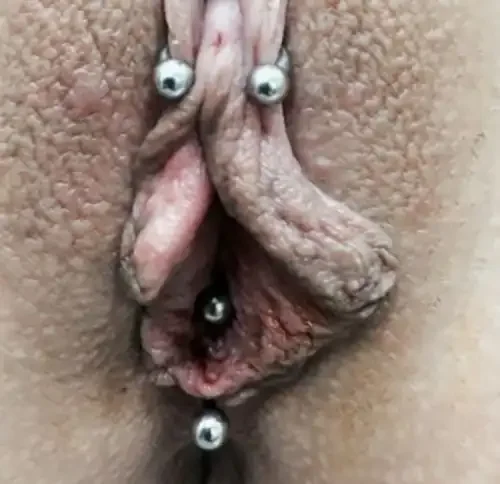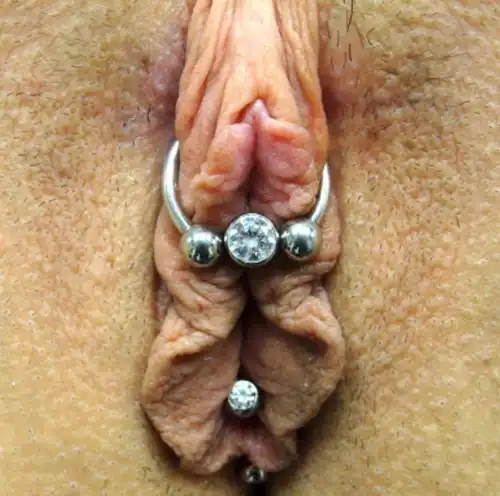Fourchette Piercing in Nairobi, Kenya
A fourchette piercing is an intimate piercing located at the posterior part of the vaginal opening, at the junction where the inner labia meet. It’s a type of genital piercing that is less common than others but can be aesthetically pleasing and enhance sexual pleasure for some individuals.

Fourchette Piercing
Anatomy and Placement
- Location: The piercing is placed through the thin piece of skin (fourchette) at the rear of the vaginal opening. It’s situated at the base of the vulva, near the perineum.
- Suitability: Not everyone has enough tissue in this area to accommodate a fourchette piercing. At Rebel Inks Tattoos, Tattoo Removal, and Body Piercings Parlour our professional piercer will assess the anatomy to determine if the piercing is feasible.
Fourchette Piercing Procedure
Getting a fourchette piercing is a delicate and intimate process that requires the expertise of a professional piercer. Here’s a step-by-step guide to what you can expect during the procedure:
- Consultation and Preparation
– Consultation: Before the procedure, you’ll have a consultation with our piercer to discuss your medical history, reasons for getting the piercing, and any concerns you may have. Our piercer will also assess the anatomy to ensure there’s enough tissue for the piercing.
– Hygiene: It’s essential to be clean before the procedure. Shower and clean the genital area thoroughly with a mild, unscented soap.
Clothing: Wear loose, comfortable clothing to your appointment to avoid irritation post-piercing. - Sterilization and Setup
– Sterile Environment: Our piercer will prepare a clean, sterile workspace. All tools and jewelry will be sterilized, often using an autoclave.
– Personal Protective Equipment: Our piercer will wear gloves and may also use a mask to maintain a sterile environment. - Marking the Piercing Site
– Positioning: You’ll be asked to lie down in a comfortable position that gives our piercer access to the area.
– Marking: Our piercer will mark the entry and exit points of the piercing with a surgical marker. You will have the opportunity to check and approve the placement before proceeding. - Piercing Procedure
– Clamps (Optional): Some piercers may use a clamp to hold the tissue in place, though this step may be skipped depending on the piercer’s technique and your anatomy.
– Needle Insertion: Our piercer will use a hollow, sterilized needle to perform the piercing. The needle is swiftly pushed through the marked tissue. You will feel a sharp, brief pain during this step.
– Jewelry Insertion: Immediately after the needle is removed, our piercer will insert the jewelry. This is typically a curved barbell or a captive bead ring made of high-quality, hypoallergenic material like titanium or surgical steel. - Aftercare Instructions
– Cleaning: You’ll be instructed on how to clean the piercing site. Typically, you should clean it twice daily with a saline solution or a mild, unscented soap.
– Avoiding Irritants: Avoid using harsh chemicals, lotions, or scented products near the piercing.
– Sexual Activity: You should abstain from sexual intercourse for at least 4 to 6 weeks to allow proper healing. When resuming sexual activity, use barrier protection methods like condoms to minimize the risk of infection.
– Clothing: Wear loose-fitting, breathable clothing to avoid irritation and friction. - Follow-up and Monitoring
– Healing Time: The fourchette piercing typically takes about 4 to 6 weeks to heal, though it can take longer for some individuals.
– Signs of Healing and Complications: Monitor the piercing for signs of proper healing, such as reduced swelling and minimal discomfort. Be aware of signs of infection, such as excessive redness, swelling, discharge, or severe pain, and seek medical advice if these occur.
– Check-ups: Schedule follow-up appointments with our piercer to ensure the piercing is healing correctly and to address any concerns.
The fourchette piercing procedure, while straightforward, requires a skilled professional due to its sensitive and intimate location. Proper preparation, adherence to sterile techniques, and thorough aftercare are crucial for a successful and safe piercing experience. Always choose an experienced and reputable piercer, and follow their instructions meticulously to ensure optimal healing and minimize the risk of complications.
Considerations Before Getting a Fourchette Piercing
Getting a fourchette piercing is a significant decision that requires careful thought and preparation. Here are key considerations to take into account before proceeding:
- Anatomical Suitability
– Tissue Availability: Not everyone has sufficient tissue at the posterior part of the vaginal opening for a fourchette piercing. Our professional piercer will assess whether you have enough tissue to accommodate the piercing safely. - Pain Tolerance and Healing
– Pain Level: Understand that the procedure involves a certain level of pain, both during and after the piercing. Pain tolerance varies among individuals, so be prepared for potential discomfort.
– Healing Process: The healing time for a fourchette piercing is typically 4 to 6 weeks, but it can take longer. During this period, you will need to follow strict aftercare protocols. - Aftercare Commitment
– Hygiene: Keeping the area clean is crucial to prevent infection. This involves cleaning the piercing twice daily with a saline solution or a mild, unscented soap.
– Lifestyle Adjustments: Be prepared to avoid sexual activity for at least 4 to 6 weeks and wear loose-fitting clothing to minimize irritation. - Potential Risks and Complications
– Infection: As with any piercing, there is a risk of infection. Signs include redness, swelling, discharge, and severe pain. Prompt medical attention is necessary if an infection occurs.
– Migration and Rejection: There is a risk that the body may push out the jewelry, leading to migration or rejection of the piercing.
– Scarring and Tearing: Scarring can occur, and the area is prone to tearing if subjected to excessive force or trauma. - Sexual Activity
– Impact on Sexual Experience: Consider how the piercing might affect your sexual activities and sensations. While some find it enhances pleasure, others may experience discomfort.
– Temporary Abstinence: You will need to abstain from sexual intercourse for several weeks during the healing process to avoid complications. - Jewelry Choices
– Initial Jewelry: Ensure that the initial jewelry is made of high-quality, hypoallergenic material such as titanium or surgical steel to minimize the risk of allergic reactions.
– Jewelry Size and Type: The initial jewelry should accommodate swelling. Consult our piercer about the appropriate size and type. - Choosing the Right Piercer
– Experience and Reputation: Select a professional piercer with experience in genital piercings. Look for reviews and recommendations.
– Hygiene Practices: Ensure the piercer follows strict hygiene protocols and uses sterilized equipment. - Personal Health
– Medical Conditions: If you have any underlying medical conditions, such as diabetes or a compromised immune system, discuss these with your piercer and possibly a healthcare provider.
– Pregnancy: Avoid getting pierced if you are pregnant due to the increased risk of infection and complications. - Cost
– Financial Consideration: The cost of the piercing includes the procedure, jewelry, and aftercare products. Ensure you budget for the entire process, including potential follow-up visits. - Psychological Readiness
– Mental Preparation: Ensure you are mentally prepared for the piercing process, the aftercare, and the potential lifestyle adjustments.
– Body Autonomy: Make sure the decision is entirely yours and that you are comfortable with modifying a sensitive part of your body.
Before getting a fourchette piercing, consider these factors carefully to ensure you are fully prepared for the procedure, the aftercare, and the potential risks and rewards. A thorough consultation with one of our professional piercer can provide further insights and help you make an informed decision. Prioritize your health, safety, and comfort to achieve the best possible outcome with your new piercing.
Pain and Healing of Fourchette Piercing
Understanding the pain involved and the healing process of a fourchette piercing can help you prepare mentally and physically for the experience. Here’s a detailed overview:
Pain Level
- During the Procedure
– Intensity: The pain experienced during the actual piercing is typically sharp and brief. Since the fourchette is a sensitive area with many nerve endings, you may feel a significant pinch or sting.
– Duration: The most intense pain lasts only a few seconds as the needle passes through the skin. Discomfort might linger for a short while afterward as the jewelry is inserted. - Immediately After the Procedure
– Soreness: You may feel soreness and throbbing in the pierced area for a few hours to a couple of days post-procedure.
– Swelling: Some swelling is normal and can contribute to the sensation of discomfort.
Healing Process
- Initial Healing Phase (First Few Weeks)
– Swelling and Tenderness: Expect swelling and tenderness for the first few days to a week. Cold compresses can help reduce swelling.
– Discharge: Clear or pale yellow discharge is typical as the body responds to the new piercing. This is part of the normal healing process. - Mid-Healing Phase (Weeks 2-4)
– Reduced Pain and Swelling: Pain and swelling should gradually decrease. If pain persists or worsens, consult your piercer or a healthcare professional.
– Crusting: It’s normal to see some crusting around the jewelry as lymph fluid is expelled. This should be cleaned gently without removing the jewelry. - Late Healing Phase (Weeks 4-6 and Beyond)
– Stabilization: The piercing should start to stabilize, with minimal discomfort and reduced discharge.
– Full Healing: Complete healing usually takes about 4 to 6 weeks, but it can take longer for some individuals.
Fourchette Piercing Aftercare
Proper aftercare is essential for ensuring a smooth healing process and minimizing the risk of complications for a fourchette piercing. Here are detailed aftercare instructions to follow:
Cleaning Routine
- Saline Solution Cleansing
– Frequency: Clean the piercing twice daily.
– Solution: Use a saline solution, which can be purchased or made at home by dissolving 1/4 teaspoon of non-iodized sea salt in 8 ounces of warm distilled water.
– Method: Soak a clean cotton pad or gauze in the saline solution and gently apply it to the piercing. Leave it on for a few minutes to soften any crusted discharge. Gently pat dry with a clean tissue or paper towel. - Mild Soap Cleansing
– Frequency: Once a day, you can use a mild, unscented soap.
– Method: Lather the soap in your hands and gently clean around the piercing. Ensure all soap is thoroughly rinsed off to prevent irritation. Pat the area dry with a clean towel.
Avoiding Irritants
- Products to Avoid
– Harsh Chemicals: Avoid alcohol, hydrogen peroxide, iodine, and other harsh chemicals that can irritate the piercing.
– Scented Products: Do not use scented lotions, soaps, or sprays near the piercing. - Clothing and Friction
– Loose Clothing: Wear loose-fitting, breathable clothing and cotton underwear to reduce friction and allow air circulation.
– Tight Clothing: Avoid tight pants, leggings, and synthetic fabrics that can trap moisture and cause irritation.
Sexual Activity
- Abstinence
– Initial Healing Period: Refrain from sexual activity for at least 4 to 6 weeks to allow the piercing to heal properly. - Resuming Activity
– Barrier Protection: When you resume sexual activity, use condoms or dental dams to protect the piercing from bacteria and friction.
– Gentleness: Be gentle and avoid positions or activities that put excessive pressure on the piercing.
General Care Tips
- Hands Off
– Hygiene: Always wash your hands thoroughly before touching or cleaning the piercing.
– Avoid Fiddling: Do not twist, turn, or play with the jewelry unnecessarily, as this can delay healing and introduce bacteria. - Monitor for Signs of Infection
– Symptoms: Be vigilant for signs of infection, such as increased redness, warmth, swelling, pus, or severe pain.
– Action: If you suspect an infection, seek medical advice promptly. - Hydration and Nutrition
– Stay Hydrated: Drink plenty of water to aid in the healing process.
– Balanced Diet: Maintain a balanced diet rich in vitamins and minerals to support your body’s healing.
Physical Activities
- Exercise: Avoid strenuous activities that may cause excessive sweating or pressure on the piercing for the first few weeks.
- Swimming: Avoid swimming in pools, hot tubs, lakes, or the ocean until the piercing is fully healed to prevent exposure to bacteria and chemicals.
Jewelry Care
- Material
– Hypoallergenic Jewelry: Use high-quality, hypoallergenic jewelry such as surgical steel, titanium, or niobium to minimize the risk of allergic reactions and irritation. - Adjustments
– Size Changes: If you experience significant swelling, consult your piercer about potentially adjusting the jewelry to accommodate the swelling without causing pressure.
– Check for Tightness: Periodically check that the jewelry is secure, but do not overtighten.
Follow-Up
- Check-Ups
– Piercer Visits: Schedule follow-up appointments with your piercer to ensure the piercing is healing correctly and to address any concerns.
– Professional Advice: Seek advice from your piercer if you experience any issues or have questions about your healing progress.
Proper aftercare is crucial for the successful healing of a fourchette piercing. By following these detailed aftercare instructions, you can minimize the risk of infection and complications, ensuring a smoother healing process. Always consult with your piercer for personalized advice and promptly address any concerns to maintain the health and integrity of your piercing.
Fourchette Piercing Jewelry
Choosing the right jewelry for a fourchette piercing is crucial for comfort, proper healing, and long-term satisfaction. Here’s an overview of the types of jewelry suitable for a fourchette piercing, materials to consider, and important factors to keep in mind:
Types of Jewelry
- Curved Barbell
– Design: A slightly curved bar with a ball on each end.
– Pros: Reduces pressure on the piercing, follows the natural curve of the body, and is less likely to cause irritation or rejection.
– Cons: Requires careful sizing to ensure it fits comfortably without causing too much movement or pressure. - Captive Bead Ring (CBR)
– Design: A ring with a small bead that is held in place by the tension of the ring.
– Pros: Allows some movement, which can be more comfortable during healing. The bead can be decorative.
– Cons: Increased movement can sometimes lead to irritation for some individuals. Requires precise placement to avoid excess pressure on the piercing. - Circular Barbell
– Design: Similar to a curved barbell but forms more of a circular shape, with a ball on each end.
– Pros: Provides a balance between the flexibility of a ring and the stability of a barbell. Less likely to shift position excessively.
– Cons: Like curved barbells, sizing is important to avoid pressure or irritation.
Materials
- Surgical Steel
– Pros: Durable, affordable, and widely used in body jewelry. Hypoallergenic for most people.
– Cons: Can contain trace amounts of nickel, which may cause issues for those with severe nickel allergies. - Titanium
– Pros: Extremely lightweight, hypoallergenic, and biocompatible. Ideal for sensitive skin and those prone to allergic reactions.
– Cons: Slightly more expensive than surgical steel. - Niobium
– Pros: Hypoallergenic, corrosion-resistant, and can be anodized for a variety of colors. Suitable for sensitive skin.
– Cons: Less commonly available and can be more expensive than surgical steel. - Gold (14k or 18k)
– Pros: Hypoallergenic if it is of high quality (14k or 18k), luxurious, and comes in various designs.
– Cons: Expensive and softer than other materials, which can lead to bending or damage.
Important Considerations
- Initial Jewelry Size
– Length and Diameter: Initial jewelry should be slightly larger to accommodate swelling during the healing process. Your piercer will select the appropriate size based on your anatomy and the specific placement of the piercing.
– Ball Size: The balls or beads on the ends should be large enough to prevent the jewelry from slipping through the piercing but not so large that they cause discomfort. - Quality
– Standards: Ensure that the jewelry meets ASTM or ISO standards for body jewelry. This ensures that the materials used are safe and biocompatible.
– Finish: Jewelry should have a smooth, polished finish to minimize irritation and prevent the buildup of bacteria. - Threading
– Internal vs. External: Internal threading (where the threads are on the inside of the jewelry) is preferable for reducing tissue damage during insertion and removal. External threading can cause microtears and is generally not recommended for new piercings.
Changing Jewelry
- Timing
– Healing Period: Do not change the jewelry until the piercing is fully healed, which typically takes 4 to 6 weeks or longer. Changing jewelry prematurely can cause irritation, infection, or injury.
– Professional Help: It’s advisable to have your piercer change the jewelry for the first time to ensure proper technique and sizing. - Signs You Need to Change
– Discomfort: If the initial jewelry causes discomfort, irritation, or signs of an allergic reaction, consult our piercer about changing to a different material or size.
– Style: Once healed, you can switch to different styles or decorative options as desired.
Choosing the right jewelry for a fourchette piercing involves considering the type, material, and quality to ensure comfort and proper healing. Always consult with one of our professional piercer for personalized recommendations based on your anatomy and preferences. Proper jewelry selection and aftercare will contribute significantly to the successful healing and long-term satisfaction of your piercing.
Cost of a Fourchette Piercing in Nairobi, Kenya
The cost of a fourchette piercing can vary based on several factors, including the studio’s location, the piercer’s experience, the quality of the jewelry, and any additional services or products provided. Here’s a detailed overview of what you can expect:
Breakdown of Costs
- Piercing Fee: This fee covers the cost of the piercing procedure itself. Prices may be higher in large cities or at renowned studios where piercers have extensive experience.
- Jewelry Cost
– Basic Jewelry: Typically includes surgical steel or titanium, which are safe and hypoallergenic.
– Premium Jewelry: Options like 14k or 18k gold, niobium, or custom designs. These materials are more expensive but are often more comfortable and durable. - Consultation Fee: Some studios charge a separate fee for the initial consultation, where the piercer will discuss the procedure, assess your anatomy, and answer any questions.
- Aftercare Products
– Saline Solution
– Mild Soap: Unscented, gentle cleanser suitable for cleaning the piercing.
– Additional Supplies: Gauze, cotton pads, or other cleaning supplies may be necessary, adding to the overall cost.
Total Estimated Cost
- Lower End: Basic piercing fee and basic jewelry. (Estimated price Ksh. 6,000)
- Mid Range: Average piercing fee and mid-range jewelry. (Estimated price Ksh. 10,000)
- Higher End: Premium piercing fee, high-end jewelry, and additional aftercare products. (Estimated price Ksh. 20,000)
Fourchette Piercing Estimated Cost Breakdown Table
Component / Service | Estimated Cost (KSh) | Details / Notes |
Procedure + basic surface barbell jewelry | 6,000 – 10,000 | Pricing reflects technical expertise and initial jewelry |
Hypoallergenic/premium jewelry upgrade | 2,000 – 5,000 | Implant-grade titanium, niobium, or custom surface bars |
Consultation & anatomical assessment | Included or +1,000 | Ensures suitability for piercing |
Aftercare kit (cleaners, saline, guidance) | 500 – 1,500 | Critical due to infection risk |
Follow-up or revision visit | 500 – 2,000 (if needed) | Especially important if irritation or migration arises |
Estimated Total (Baseline Package) | 6,500 – 12,500 | Procedure + standard jewelry + aftercare kit |
All-Inclusive with Upgrades & Support | 10,000 – 20,000 | Full service, high-end jewelry, extended aftercare support |
Additional Factors Influencing Cost
- Location
– Urban vs. Rural: Prices are generally higher in urban areas or large cities compared to rural or suburban locations due to higher operational costs.
– Country: Costs can vary significantly depending on the country and local market rates. - Studio Reputation
– Reputation and Hygiene: Studios known for their hygiene, safety standards, and quality of service may charge more. Paying extra for a reputable studio can ensure a safer and more professional experience. - Piercer’s Experience
– Experience Level: More experienced piercers or those with specialized training may charge higher fees. Their expertise can be valuable, especially for intimate piercings like the fourchette. - Jewelry Quality
Initial Jewelry: High-quality jewelry is crucial for proper healing and minimizing the risk of allergic reactions or complications. Investing in better jewelry can ensure a smoother healing process and long-term comfort.
Potential Additional Costs
- Follow-up Visits: Some studios include follow-up visits in the initial fee, while others may charge separately for these check-ups to monitor the healing process.
- Jewelry Changes: If you need to change the jewelry due to swelling or personal preference, there may be an additional cost for new jewelry and the service.
The cost of a fourchette piercing varies widely based on several factors, including the studio location, piercer’s experience, and jewelry quality. It’s important to choose a reputable piercer and high-quality jewelry to ensure the best possible outcome and minimize the risk of complications.

Possible Side Effects of Fourchette Piercing
Getting a fourchette piercing involves certain risks and potential side effects. Understanding these can help you make an informed decision and take appropriate steps to minimize them. Here’s a comprehensive overview of the possible side effects:
Immediate Side Effects
- Pain and Discomfort: Pain and tenderness are expected immediately after the piercing. The level of pain varies depending on individual pain tolerance and the skill of the piercer. Over-the-counter pain relievers like ibuprofen can help manage discomfort.
- Swelling: Swelling around the pierced area is common and usually subsides within a few days to a week. Applying cold compresses can reduce swelling. Avoid tight clothing that might aggravate the area.
- Bleeding: Minor bleeding during and shortly after the piercing procedure is normal. Keep the area clean and avoid unnecessary movement that could exacerbate bleeding.
Short-term Side Effects
- Infection: Infections can occur if bacteria enter the piercing. Signs include redness, warmth, swelling, discharge, and increased pain. Strict adherence to aftercare instructions is crucial. Clean the piercing regularly with saline solution and avoid touching it with dirty hands. If an infection is suspected, seek medical attention promptly. Antibiotics may be required.
- Irritation: The piercing can become irritated by friction from clothing or excessive movement. Wear loose-fitting clothing and follow the aftercare guidelines provided by your piercer.
- Allergic Reactions: Some individuals may have an allergic reaction to the metal in the jewelry, leading to itching, redness, and swelling. Use hypoallergenic jewelry made from materials like titanium, niobium, or high-quality surgical steel. Switch to jewelry made from hypoallergenic materials if an allergic reaction occurs.
Long-term Side Effects
- Migration and Rejection: The body may push the jewelry out, causing the piercing to move (migrate) or be completely expelled (rejection). Ensure the jewelry is of appropriate size and material. Avoid unnecessary pressure on the piercing. If migration or rejection occurs, consult our piercer. The jewelry may need to be removed, and the area allowed to heal before attempting to re-pierce.
- Scarring: Scarring can occur during the healing process. This may include hypertrophic scars (raised scars) or keloids (larger, raised scars). Proper aftercare and avoiding trauma to the area can minimize the risk of scarring. If scarring develops, treatments such as silicone gel sheets or scar creams may help. Consult a dermatologist for persistent issues.
- Tearing: The piercing is at risk of tearing if subjected to excessive force or trauma, especially during sexual activity or vigorous movement. Handle the area gently and avoid activities that put stress on the piercing during the healing phase. If a tear occurs, seek medical attention. The jewelry may need to be removed, and the area allowed to heal before re-piercing.
Psychological Effects
- Emotional Impact: As with any body modification, there can be psychological effects, both positive and negative. Some may experience increased confidence and satisfaction, while others might have second thoughts or regret. Ensure you are mentally prepared for the piercing and have considered the decision thoroughly. Consulting with a professional piercer and understanding the process can help mitigate negative feelings.
Sexual Activity
- Temporary Abstinence: Sexual activity should be avoided for at least 4 to 6 weeks during the initial healing period to prevent complications. Follow our piercer’s advice on when it’s safe to resume sexual activities. Use barrier methods like condoms to reduce the risk of infection and irritation.
A fourchette piercing, while unique and potentially rewarding, comes with several possible side effects. Being aware of these risks and taking proper aftercare measures can help ensure a smoother healing process and reduce the likelihood of complications. Always consult with an experienced professional piercer, follow their aftercare instructions closely, and seek medical advice if any issues arise.
Get In Touch
For more information on the list above and any other special services,please call or come in for free consultation
Testimonials
I am extremely happy with my new 'Safari' tattoo from Eric at Rebel Inks! The quality of the artwork is fantastic. Eric is a true professional and an amazing artist.
The preparation and design process was thorough and collaborative. He was very patient with my specific requests, including making sure all the elements, which hold personal meaning, were perfect.
The service was friendly and highly professional from start to finish. Despite the 8-hour session, Eric was a pleasant person to spend the time with.
The aftercare guidance and follow-up have been excellent and careful, which has made the healing process easy and better than expected.
I highly recommend Eric for anyone looking for a thoughtful, talented, and caring tattoo artist.
I recommend them 💯
I would definitely recommend if you’re thinking of getting a piercing!
The staff were super friendly, explained everything clearly, and made me feel so at ease. They answered all my nervous questions (and I had many questions),
They walked me through the whole process, gave detailed aftercare instructions, and even followed up afterward to check how I was healing 🫶
Clean, professional, and full of good vibes.
Would 100% recommend . Definitely making a second trip here.
This was the second tattoo I got and I wish I could have come to Eric for my first one! He gave me really great after-care directions for the tattoo as well as a little jar of his own Vaseline-type stuff to put over my tattoo while it was healing! He even put second skin over my tattoo so that I didn’t have to worry about it for the first few days. Now THAT’S good service. My first tattoo artist didn’t do none of that lol.
After the session Eric didn’t rush me and my friend out, he chatted with us and even when he found out I was an artist too— really encouraged me to keep creating and to find a community of artists to support me. I almost cried because I’ve had such a hard time with my own art the past couple of years, it meant so much to me to have a fellow very talented artist say that to me. 🤍🤍🤍
Eric you’re amazing, don’t ever stop creating and just know you’ve impacted lives all over the world!🫶🏻 thanks so much for everything!!
From the moment I walked in, Eric was professional, welcoming, and attentive. He made sure I was comfortable throughout, provided everything I needed, and explained every step of the process. The tattooing itself was unbelievably smooth - I genuinely felt no pain compared to my previous tattoos over the last 22 years.
Eric also gave me excellent aftercare guidance and products, and thanks to that, my tattoo healed beautifully. The attention to detail, precision, and shading are absolutely stunning. This is hands-down the best tattoo I've ever had, and I will be flying back to Nairobi for any future ink.
If you want incredible art, a professional experience, and a talented artist who truly cares about his clients, Rebel Ink is the place to go!
From start to finish, the service was exceptional. The piercer was professional, knowledgeable, and made me feel completely comfortable. The cleanliness of the place was above and beyond — everything was spotless and hygienic, which really put me at ease. Highly recommend for anyone considering a piercing!
Shout out to Eric😘
We ended up changing the jewelry three times to ensure I had the best fit and avoided any signs of rejection, and he always listened to my suggestions as a client, which I really appreciated. Now, three months in, my piercing is healing beautifully, with no sign of rejection. Highly recommend for anyone who values a piercer who cares about your comfort and healing journey!
What stood out the most was the aftercare Eric checked in with me even three weeks later to see how the tattoo was healing. That kind of follow-up shows how much he truly cares about his work and his clients.
I’m very satisfied and will definitely be coming back for my next piece. Highly recommend!
The piercing wasn't as painful as I had thought and the process was quick and satisfactory. I love it!!!
The piercing is healing well thanks to the aftercare instructions and follow-up. I would highly recommend Rebel Inks
Eric also did a belly button piercing for a friend, guiding her through the process, doing the piercing and then explaining the after care to her.
The shop is on the 3rd floor, with the entrance to the stairs near an alleyway on the left. The shop is perfect size, clean, and attractive looking. The mural is pretty dope.
Thank you for the amazing service! 🔥👅✨
I got piercibgs there and the process was really good. My biggest concern was hygiene but that wasn't an issue at all, they use new needles and they sanitize them.
The service itself was also welcoming.
I was informes of everything i needed to know beforehand.
10/10 would recommend!
Eric was so calm and patient with my almost 2 year old lady. It was such a clean and hygienic process. We will definitely be back for our second rounds of piercings and maybe even another tattoo!
They assess the area before any art and advise one accordingly. They also give one post clean up process and also do a check up after the body art projects. Overall, I loved my experience and I’m hooked. 👍
Will definitely come back next time I’m in town 🙂
He listened to what I actually wanted and made sure he could fit in the time before I flew back home.
The shop is clean & private and is easy enough to find.
Eric has even checked in a couple of times since to make sure all is good.
I would totally recommend Eric! I absolutely love my Elephants!
I had a very easy healing period and always follow up from Eric to check on my progress...I would highly recommend if you are a first timer because from my experience all went very well and attention to detail
Thank you for a good job and looking forward to send all my friends your way
And all the best with the new year 2025!
From the moment I walked in, the staff was super friendly and made me feel at ease. The studio had a clean, professional atmosphere, which immediately put me at ease. My piercer was incredibly skilled and explained every step of the process, ensuring I was comfortable the entire time. The piercing was quick and practically painless, and the aftercare instructions were clear and easy to follow. I can tell they really care about the health and safety of their clients.
Overall, a fantastic experience—I highly recommend Rebel Inks and Tattoos for anyone looking to get pierced or tattooed!
They do follow up after their services
Eric's Studio isn’t just a place to get a tattoo—it’s an experience. The combination of professionalism, artistic talent, and a welcoming environment makes it a standout destination for anyone considering a tattoo.
I highly recommend Eric’s Studio to both first-timers and seasoned tattoo enthusiasts. If you’re looking for a high-quality tattoo and an enjoyable experience, this is the place to go.
I would definitely recommend their services again and again
Thank you Rebel Ink
My piercings are healing ❤️🩹 well
I would 💯 recommend
I will definitely come back for more .
Two, all the equipments he used for the piercings were new and/or sterilised.
Three, the parlour itself was very clean and was up to par with the hygiene standards.
Four, Eric provided effective aftercare instructions, making sure I knew exactly how to take care of my new piercings and he kept in touch and continues to do so, to check on the healing progress.
I highly highly highly recommend this place!!!
Would definitely recommend them to friends and go back for other piercings
Not only was the piercing process smooth, but he also provided thorough aftercare instructions, making sure I knew exactly how to take care of my new piercings. What really impressed me was that he keeps in touch to check on how the healing is progressing – a sign of true care for his clients.
The shop maintains a high standard of hygiene, and the atmosphere is welcoming and comfortable, which really added to the positive experience. I highly recommend this place to anyone looking for a professional and caring experience. I’ll definitely be coming back for any future piercings!
My appreciation for the excellent customer service I received. The follow-ups were prompt, and I truly appreciated the gentleness and professionalism throughout. Thank you!"
"Looking for professional eyebrow microshading removal? Look no further!"
The customer care is top tier 👌🏾👌🏾.
Wonderful place to get tattoos and piercings. 💯💯
Eric goes ahead to follow up on his clients progress and gives good advice each time I reach out to him.
I would recommend Reble tattoos anytime.
Good job bro we really appreciate.
Ohh and the price is very fair.
The environment was clean , procedure was sterile and the jewelry used are of the best quality.
He followed up with me during the healing process, he educated me on what I needed to do for my aftercare.
Eric is confident, skilled , experienced and the best piercer. Highly recommend Rebel inks.✨
Definitely recommend!
Great experience.
Eric definitely know what he is doing .
I got exactly what I wanted 2 tiny tats on the same finger .
He was kind and patient throughout the session.
Healing process has been good .
Aftercare services were given and regular checkups on the healing process were done.
I would 💯recommend.
Eric gave me the best reception as it was my first time there,and made me trust him all the way. I appreciate good services.
There services are also affordable not to forget 😊.
He was also invested in the aftercare and would ensure I follow the do's and don'ts in taking care of the tattoo and ensuring proper healing and maximum ink retention.
Would highly recommend Rebel Inks Tattoos.
Rebel Inks Tattoo offer the best,affordable and quality tattoo removal services.If you have unwanted ink,choose Rebel Inks Tattoo,they're the best of the best and the professionalism is a top notch.They ensure you're free from unwanted ink with their Laser Tattoo Removal Technology...
I did a Laser Tattoo Removal with them and i can attest they're the best....
Kudos Eric...
I highly recommend.
It was a generally good experience with good hygiene during the piercing process and has been a smooth healing process.... 10/10
tips. Highly recommend 👍🏽
100% recommendable.
I was particularly impressed with Eric's attention to hygiene. He thoroughly cleaned the room before I entered, sanitized all of the equipment he would be using, and changed gloves between each ear. This level of cleanliness gave me great confidence in his professionalism.
Eric's commitment to customer service did not end on the day of the piercing. He followed up with me regularly throughout the healing process to ensure that I was following the aftercare instructions and that my earlobes were healing properly.
I highly recommend Rebel Inks to anyone in Nairobi who is considering getting a piercing. Eric is a highly skilled and experienced piercer who takes great pride in his work.
So I Check all the boxes below and more:
Customer Care: ✔️
Professionalism : ✔️
Cleanliness ✔️
Price: ✔️
After care service ✔️
Thanks and good job, Eric
The place is neat and clean and the equipments he used were also fine standards. Really appreciate his following up with me on the healing 🤗
I WOULD HIGHLY RECOMMEND THEIR SERVICES to everyone. Actually what you see on their website is EXACTLY what you will get. Keep up the good work Rebel inks Tattoos.
The infection is now gone. I would definitely recommend!
Can recommend this place totally and would go back there anytime!
Thanks!
OUR LOCATION
Areas We Serve
NAIROBI
KIAMBU
KAJIADO
MACHAKOS





































































































































































































































